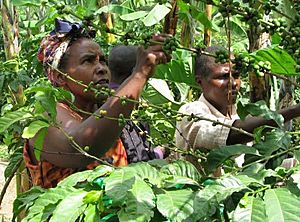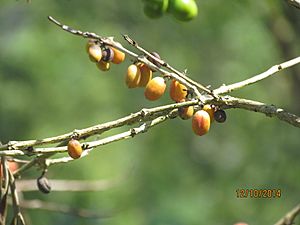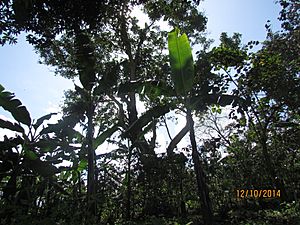Coffee production in Uganda facts for kids
Coffee is a very important crop for Uganda. It is the country's top export, meaning it's the main product Uganda sells to other countries. In fact, Uganda is special because it's one of the few places where a type of coffee called Robusta coffee grows naturally, especially around Lake Victoria.
Farmers in Uganda also used to grow cocoa trees alongside their Robusta coffee. However, cocoa production went down in the 1970s and 1980s. Even though Ugandan cocoa was good quality, not many international investors were interested. The government kept trying to help the cocoa industry grow again. In 1991, the Uganda Coffee Development Authority was created to help the coffee industry become more open and competitive.
Robusta coffee grows naturally in areas like the Kampala forest and near Lake Victoria. From 1999 to 2002, there was a plan to sell this wild coffee as a special, high-quality brand. This idea was inspired by the success of shade-grown coffee in Central America. The Kibale Wild Coffee Project, supported by groups like the World Bank, aimed to harvest coffee from Uganda's natural areas in a way that helps the environment. It also made sure that all workers were paid fairly. The money earned from this coffee was meant to help pay for conservation efforts.
Another type of coffee, Arabica coffee, grows on the slopes of Mount Elgon. This coffee was brought to Uganda from Ethiopia and started growing naturally there.
Contents
Coffee Farming in Uganda
Coffee Types and Where They Grow
Coffee has been Uganda's most important crop for many years. Farmers grow about 191,700 hectares of Robusta coffee. Most of this is in southeastern Uganda. They also grow about 33,000 hectares of Arabica coffee. This type grows in the higher areas of southeastern and southwestern Uganda.
Helping Coffee Farmers
Between 1984 and 1986, a group called the European Economic Community (EEC) helped Uganda's coffee industry. They started a program to improve coffee production. This program also supported research and training for farmers. It helped them learn new skills and understand how important their role was to the country's economy. Some money was also used to fix coffee factories.
When Yoweri Museveni's government came to power in 1986, they wanted to improve coffee farming. They also wanted to stop coffee from being smuggled out of the country. Another goal was to grow other crops so Uganda wouldn't depend only on coffee. To do this, the government raised the prices paid to coffee farmers in 1986 and 1987. They said these new prices were fairer.
Challenges for Coffee Farmers
By December 1988, the Coffee Marketing Board had problems paying farmers for their coffee. They owed a lot of money to farmers and banks. Even though the government promised to help, some payments were delayed for a year.
Uganda was part of the International Coffee Organization (ICO). This group of coffee-producing countries set limits on how much coffee each country could export and at what price. Uganda's share was only 4 percent of all coffee exports worldwide. In 1989, the ICO agreement broke down because members couldn't agree on quotas and prices. This meant that coffee prices around the world dropped very quickly. This was a big problem for Uganda's economy.
In October 1989, the government made the Ugandan shilling weaker. This made Uganda's coffee cheaper for other countries to buy. However, the drop in world coffee prices still hurt the country. In 1990, coffee production went down by more than 20 percent. This was due to dry weather, management issues, low prices, and farmers choosing to grow food crops instead of coffee.
Coffee in the 1990s
After leaving the International Coffee Organization, the Ugandan government kept working to boost its coffee exports. In 1991, the Uganda Coffee Development Authority (UCDA) was created. This group helped the coffee industry become more open. The UCDA is managed by Uganda's Ministry of Agriculture. During the 1990s, the UCDA saw a huge increase in coffee exports. This was partly because coffee prices were high in the world market. Between 1993 and 1997, international sales of Robusta coffee grew to 110,000 tons each year.
Coffee Challenges in the 2000s
Around the year 2000, coffee production in Uganda slowed down again. One main reason was that people wanted less coffee, which led to lower prices. Also, a serious plant disease called Coffee wilt disease spread. This fungus kills coffee plants completely. Trees with this disease cannot be saved and must be removed to stop it from spreading. By 2003, almost half of Uganda's Robusta coffee trees had died from this disease. Because of this, coffee exports dropped a lot, from 143,441 tons in 2000 to 122,369 tons in 2004.
Arabica Coffee Production
Arabica coffee is often grown on small farms mixed with food crops like beans, peanuts, and bananas. It usually grows under shade trees. These trees help the coffee plants grow well and keep the soil healthy. The leaves that fall from the shade trees become natural fertilizer for the coffee plants.
In a place called Mbale, farmers plant Arabica coffee between March and April. They harvest the coffee between August and November. The coffee trees are trimmed from December to February, before the new planting season. The trees flower during the dry season.
After Harvesting Arabica Coffee
Arabica coffee goes through a "wet processing" method. First, the outer skin of the red coffee berries is removed. This is called pulping. After pulping, the sticky layer around the bean is washed off with water. The coffee beans are washed in a special basket made of sisal.
Farmers then have two ways to dry their coffee beans. They can dry them under the sun until they have the right amount of moisture. Or, they can pay to have them dried at a coffee factory. The next steps include removing the coffee husks, sorting the beans by size, roasting them, grinding them, and finally packaging them.
Robusta Coffee Production
Robusta coffee comes from a plant called coffea canephora. It mostly grows in the Lake Victoria Basin. This type of coffee is known for being less acidic and more bitter than Arabica coffee. Robusta beans usually grow in lower areas, between 200 and 800 meters above sea level.
Robusta coffee plants are also stronger and produce more coffee per area than Arabica plants. The cost of harvesting Robusta beans is also lower. Another good thing about Robusta is that it's more resistant to diseases that can harm coffee plants. This makes it a safer crop for farmers to rely on. However, because it's more bitter, it's not as popular in the global market as Arabica coffee.
Even though Robusta coffee is strong and resists disease, it is very sensitive to climate change. Studies show that if the temperature goes up by just 2 degrees Celsius, the amount of coffea canephora that can grow in Uganda could drop a lot.
Kibale Wild Coffee Project
What Was the Project About?
Robusta coffee grows naturally in the Kibale forest area. From 1999 to 2002, there was a plan to sell this wild coffee as a special, high-quality brand. The idea was to use the money from selling this coffee to help protect the environment.
The project got its first money from USAID. Then, it received more funding from the Ford Foundation and the World Bank. The project successfully set up ways to control how the coffee was produced and its quality. At first, the Uganda Coffee Trade Federation led the project. Later, a group called the Kibale Forest Foundation took over. This foundation was approved by Uganda's government. Its main job was to check how wild coffee was harvested. It also made sure that workers were paid fairly. Workers received direct wages and also benefits from public projects chosen by the community. It was thought that about 1,500 pounds of coffee could be harvested sustainably each year.
Another goal of the project was to reduce inequality between men and women. At that time, women did about half of the work in growing cash crops, including coffee. The project wanted to make sure that men and women received the same pay for the same work in coffee production.
The coffee was certified as organic by a Swedish company called KRAV since 1994. One way they did this was through a program that helped farmers get organic certification and set up systems to control quality for marketing.
Why the Project Ended
Later, it was found that there wasn't much demand for this wild Robusta coffee. People who buy high-quality coffee usually prefer Arabica coffee. Different ideas for mixing the wild Robusta coffee with other types were not accepted by coffee sellers. Project leaders believed that they would need to spend a lot of money, about $800,000, just to create demand for the product. Because of this, the project eventually ended.
Images for kids













